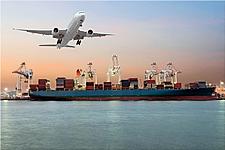 |
Ocean Freight
Ocean container lines are fighting a losing battle to inject sufficient capacity into the market, as schedule delays absorb the vast amount of additional tonnage that has already been deployed on key trade lanes. While shipping data is showing a very modest global demand growth, and a genuine demand boom only into North America, most freight rates continue to set records and shippers find themselves in a situation of fighting over available capacity. The current predicament is driven mainly by a lack of capacity, not by a demand boom.
In practical terms, a carrier offering a weekly service using 10,000 teu vessels on the transpacific lane would need six ships for the six-week round trip. However, if this were delayed by a week due to port congestion at either end of the voyage, an additional vessel would be required to maintain the same capacity.
On a pure year-on-year basis, carriers are increasing capacity by more than 20%, but this increase is more an effect of the sharp drop in capacity in spring 2020, than of an actual increase. Compared to 2019, capacity has shown an average annual increase ranging from 5-10%.
Irrespective of whether we measure year on year or comparing to two years ago, the net capacity development is negative. This means that despite the injection of significantly more vessels into the transpacific, the cargo-carrying capacity on a roundtrip-basis measured in teu/days has actually declined.
Sea-Intelligence liner schedule data showed that in February, almost 12% of global capacity was absorbed by delays. By April, this had dropped to 8.8%, but has since increased to 9.6% in June 2021.
Building more vessels will not materially solve the problem, partly because vessels ordered today mainly get delivered in late 2023 and in 2024, and partly because injecting more vessels compounds the bottleneck problems in ports, effectively increasing the delay time.
Airfreight
In terms of the global airfreight market, it definitely has benefitted from the ongoing issues in the ocean freight market, as cargo owners look for a quicker alternative to move their freight. In addition, as ocean freight becomes more expensive, it has made the price of airfreight easier to rationalize. Air cargo was over twelve times more expensive than ocean shipping prior to the crisis, but this fell to a ratio of six in May 2021. This has resulted in companies using airfreight to move goods not typically transported via plane.
While the global air cargo market now seems to be getting slowly back on track, we expect air cargo capacity to remain constrained through at least the first half of calendar year 2022. Recovery will be slow, potentially episodic, and a full recovery is not anticipated until 2024.
The recent uptick in passenger air travel has seen a significant number of passenger freighters (preighters) returning to passenger mode, raising fresh concerns that the air freight capacity squeeze is set to intensify as the peak season approaches.
The overall picture of airfreight is also about how this market recovery is playing out, because it’s going to be extremely uneven. Demand patterns for passenger travel have changed dramatically since the pandemic, with some markets now reopening much faster than others. The demand in the U.S., for example, is for domestic travel. In Europe, it’s for intra-European travel.
Unfortunately, this doesn’t do anything to help the capacity situation for international airfreight, which requires widebodies flying internationally, as that demand is still down 80% and we don’t anticipate this improving anytime soon. In fact, we are taking a step in the other direction, as countries continue to lock down as the Delta variant takes hold. So, international demand is going to continue to be down and is going to recover very unevenly.
One key point to make here is that the boom in domestic (US passenger) traffic is actually impacting cargo capacity in a negative way because a lot of the preighters that have been flying in the Pacific, for example, have been pulled back by the carriers to fly domestic passenger missions. Taking a specific example, United Airlines was flying about 1,500 preighters a month in June, but this had gone down to zero in July.
For more information, contact David Lychek, Manager – Ocean & Air Services.
















